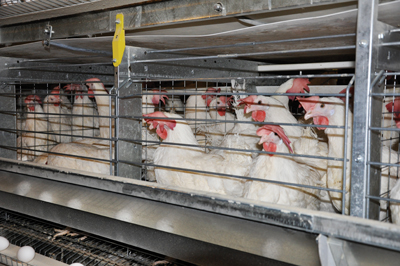
Vocalization and Stress
By Poultry Science Association
Features Profiles ResearchersResearch data on laying hens confirm that vocalization patterns
Dr. Dolittle famously walked and talked with the animals. Poultry
scientists can’t do that with chickens – yet. But they are learning how
to interpret what chickens are “saying” about stressors in their
environment.
Dr. Dolittle famously walked and talked with the animals. Poultry scientists can’t do that with chickens – yet. But they are learning how to interpret what chickens are “saying” about stressors in their environment. Ongoing research on laying hens has demonstrated that bird vocalizations can serve as reliable indicators of particular forms of stress and that different vocalization patterns can be linked with specific kinds of stressful conditions.
 |
|
| Researchers are examining the different vocalizations exhibited by laying hens in the hope of identifying when the birds are stressed, and what the cause of the stress is. Advertisement
|
Knowing whether and when specific environmental conditions induce stress is a first step towards reducing stress in the production environment, according to Dr. Michael J. Darre, a professor in the Department of Animal Science, University of Connecticut, and a member of The Poultry Science Association (PSA).
Currently, the only clinical tool for directly measuring stress levels – taking a blood sample and analyzing levels of traditional stress indicators such as cortisol and adrenaline – is itself likely to induce further stress in the animal. Another drawback is the time delay between the initial cause of the stress and running the appropriate clinical blood tests.
“Alleviating stress in commercial flocks of laying hens and broilers is important not only because it improves the overall welfare of the birds, but also because stress is a known enemy of production efficiencies,” said Dr. Darre. “Chronic stress has been shown to reduce egg production, reduce growth and meat yields, and lower immune system function.
“And yet finding a practical, non-invasive way to assess stress in chickens has proven to be a difficult challenge. Research involving the analysis of chicken vocalizations may well provide the answer, because it is non-invasive and provides immediate and accurate feedback on levels and types of bird stress.”
The Dolittle Project
Joining Darre in his work on chicken vocalizations is one of his doctoral students, Ebenezer Otu-Nyarko. They are participants in a wider study called the Dolittle Project: Classifying Animal Vocalizations (http://speechlab.eece.mu.edu/dolittle/library.html). Funded through the National Science Foundation, the Dolittle Project is the first ever to apply modern speech-processing algorithms to animal vocalizations.
Participants in the project study – and attempt to classify – a wide range of vocalizations of both domesticated and non-domesticated animals, including chickens, horses, dogs, tigers, rhinoceroses, beluga whales and bottle-nosed dolphins.
The lead investigator of the Dolittle Project is Dr. Michael Johnson, a professor in Marquette University’s Department of Computer and Electrical Engineering. In addition to Marquette and the University of Connecticut, project participants include Dr. Peter Scheifele at the University of Cincinnati’s Communications Disorders department, Disney’s Animal Kingdom, the Fauna Research Communications Institute, the University of Central Florida, and Adam Mickiewicz University in Poznan, Poland. Work on the Dolittle Project began in 2004.
Vocalizations as Stress Indicators
According to Dr. Darre, one of the primary initial goals of the work on chickens was to determine if vocalization patterns were the same for all types of stressors; research has shown that they are not. For example, vocalization patterns have been found to be different for stress due to handling and stress due to overcrowding.
The analysis was carried out by digitally recording laying chickens’ vocalizations under different types of stressful conditions, and then, after removing background noise, analyzing the recordings using a modified version of the Hidden Markov Model (HMM) with voice recognition algorithms. The modified HMM is a statistical model developed by Marquette University that represents both the temporal and spectral characteristics of audio signals. When applied to chicken vocalizations, HMM has achieved an overall condition classification accuracy of 74 per cent.
Darre and Otu-Nyarko are also looking at how vocal patterns change from the time chickens hatch until they are adults.
The ultimate goal of their work, according to Dr. Darre, is to develop a “black box” that can be placed in chicken houses that allows farmers to remotely monitor their birds, notifies the farmers when it detects stress vocalizations, and identifies the type of stress, so that action can be taken immediately to address the situation.
“This kind of monitoring would help reduce overall stress in flocks and be a great step forward in improving the welfare of commercial bird flocks. This in turn would benefit farmers, and ultimately the consumer, via improved egg-laying and meat output due to the known benefits that accrue from keeping chickens in a lower-stress environment,” said Dr. Darre.
Print this page